|
|
|
|
|
|
|
|

| Disclaimer Information in this document is provided in connection with Intel products. No license, express or implied, by estoppel or otherwise, to any intellectual property rights is granted by this document. Except as provided in Intel's Terms and Conditions of Sale for such products, Intel assumes no liability whatsoever, and Intel disclaims any express or implied warranty, relating to sale and/or use of Intel products including liability or warranties relating to fitness for a particular purpose, merchantability, or infringement of any patent, copyright or other intellectual property right. Intel products are not intended for use in medical, life saving, or life sustaining applications. Intel may make changes to specifications and product descriptions at any time, without notice. Copyright © Intel Corporation (1996). Third-party brands and names are the property of their respective owners.
|
|
1.0. INTRODUCTION
2.0 THE GOURAUD SHADING ALGORITHM
3.0. INPUT AND OUTPUT DATA REPRESENTATION
4.0. CODE PARTITIONING
|
The Intel Architecture (IA) media extensions include single-instruction, multi-data (SIMD) instructions. This application note presents examples of code that exploit these instructions. Specifically, the Gouraud Shading algorithm presented here illustrates how to use the new MMXTM technology instructions to achieve better performance in color rendering. The performance improvement relative to traditional IA code can be attributed primarily to the technique of processing multiple data elements in parallel.
Gouraud shading is a scan line algorithm used to render objects smoothly in three-dimensional (3D) graphics. If a scan line algorithm is used to render an object, a value for the intensity of each pixel along the scan line must be determined from the illumination model. In implementation, the object is divided into polygonal surfaces. Each individual polygonal surface is rendered as a sequence of scan lines. Gouraud shading first determines the intensity at each polygonal vertex, then uses a bilinear interpolation to determine the intensity of each pixel on a scan line.
| Ia Is Ip Ie Ic Ib |
Figure 1 and the formulas shown in Figure 2 illustrate how this is done. It is assumed that S and E are intersection points of a scan line and a triangle (Figure 1).
|
Is
= v * Ia + (1 - v)*Ib 0 <= v <= 1 (1)
Ie = t * Ia + (1 - t)*Ic 0 <= t <= 1 (2) Ip = u * Is + (1 - u)*Ie 0 <= u <= 1 (3) Ip(i+1) = Ip(i) + dI i = 1,2,...n-1 (4) dI = ( Ie - Is )/(n-1) (5) |
The bilinear interpolation is performed in two steps:
1. Intensities Is, Ie at the pixels S and E are determined by linearly interpolating the intensities of the triangle vertices. This is shown in Formulas 1 and 2.
2. The intensity Ip at a pixel P on the scan line is also obtained by linearly interpolating along the scan line between S and E, as shown in Formula 3.
The example code in this application note performs the second step of linear interpolation as shown in formula 3. Because addition takes fewer cycles than multiplication, if addition is the only operation necessary, Formula 4 is used instead of Formula 3.
Where Ip(i) is the intensity of the ith pixel, n is the number of the pixel on the scan line, dI is the incremental intensity for each successive pixel. Formula 5 shows how this is calculated.
The intensity of a pixel is represented by a 32-bit DWORD in which RGB values, each represented by eight bits, are stored in the first 24 bits. In order to reduce loss of accuracy due to truncation resulting from Formula 5, the incremental values of dR, dG, and dB are represented as a fixed-point notation stored in a 16-bit SWORD. The fractional part is stored in the first eight bits and the integer part in the remaining eight bits. Refer to Figure 3 for further clarification.
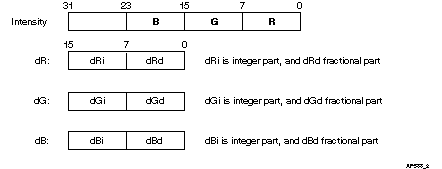
We assume that the ranges of RGB values are from 0 to 255 and that there are at least four pixels on the scan line. Hence the ranges of dR, dG and dB values are from -255/4 to 255/4. The resulting intensities are stored in an array of DWORD. If there are fewer than four pixels on the scan line, there is little performance benefit from coding in assembly language. C language code should be used instead.
The procedure primarily consists of two main sections: a data setup section and an inner loop section in which intensities are assigned to four pixels. In both sections, the code fully exploits SIMD techniques to process four intensities in parallel.
In the data setup section, the task is to prepare data as shown in Figure 4 for the inner loop. This data will be stored in MMXTM registers or memory locations.
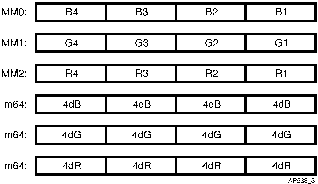
The MMX registers MM2, MM1 and MM0 hold RGB values for four consecutive pixels, where R2 = R1 + dR,... R4 = R3 + dR ... etc. R1, R2, R3, R4, each 16 bits, serve as accumulators. Like dR, color values of R1, R2, R3, R4, are also represented in fixed-point notation. Four times the incremental color values dR, dG and dB are stored in four consecutive memory locations and are used for accumulation of color values for R,G and B in the inner loop. This setup code allows us to evaluate Formula 4 for four adjacent pixels in parallel. The computation flow for R1, R2, R3, R4 (shown in Figure 4) is shown in Figure 5.
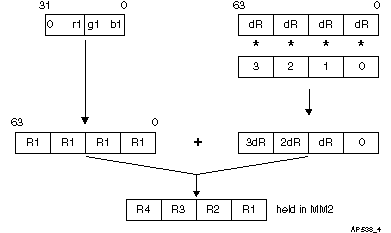
An alternative approach would have been to prepare registers that contain [0,B1,G1,R1] and [0,dB,dG,dR]. This approach was rejected because the inner loop would only do three calculations in parallel instead of four. Hence this alternative has poor performance for scan lines with many pixels, where performance is needed most.
Example 1 shows a sequence of MMX instructions that extract the R color value (r1 in Figure 5) from RGB1, and load r1 to the higher byte of four words in MM2. Here RGB1 is a 32-bit input data that holds the intensity of the first pixel on the scan line.
movdt mm6, Rgb1 ; load R1,G1,B1 intensities to lower three bytes of mm6 punpcklbw mm6,mm6 ; unpack R1R1,G1G1,B1B1 to the first 3 words of mm6 movq mm7, mm6 ; load R1R1,G1G1,B1B1 to the first 3 words of mm7 punpcklwd mm7,mm7 ; unpack R1R1,R1R1,G1G1,G1G1 to the four words of mm7 pxor mm2,mm2 ; clear mm2 for use by unpack punpcklbw mm2,mm7 ; unpack R1 to the higher byte of the four words of mm2
A similar set of instructions can be used to form [G1,G1,G1,G1] and [B1,B1,B1,B1]. Each of these three sets of instructions do not pair well because many of the instructions operate on the result of the immediately preceding instruction. However, by interleaving these three groups of instructions, the resulting code pairs very well. (See Appendix A.)
There are two tasks to be accomplished in the inner loop: calculating intensities for four consecutive pixels and updating MM0, MM1, and MM2. Computation flow for the parallel processing of data in MM0, MM1, and MM2 into four 32-bit RGB intensities is shown in Figure 6. MM2, MM1, and MM0 serve as accumulators of RGB color values. Their initial values are calculated in the data setup section described in section 4.1. Their values are updated by adding the incremental dR, dG and dB for each pass through the inner loop as shown in Figure 7.
As mentioned in section 4.1, R1, R2, R3, and R4 are represented in fixed-point notation with the first 8 bits representing the fractional part and the remaining 8 bits the integer part. Values r1, r2, r3, and r4 shown in Figure 6 are the integer parts extracted from R1, R2, R3, and R4 and similarly for g1, g2, g3, and g4 and b1, b2, b3, and b4.
Since we process four pixels at a time, we need to handle the remainder if the number of pixels on a scan line is not a multiple of four. One approach is to process the remainder outside the inner loop. The drawback of this approach is that it needs four extra conditional jump instructions to differentiate four possible values of remainder, which would be 0,1,2, or 3. If done this way, the total cycles needed to process the remainder outside the inner loop would be more than 10.
A better approach is to handle the remainder in the inner loop. In this implementation, the output is stored into an array, and the calling routine transfers the pixels to the display. Since the caller can simply ignore unwanted pixels, the only cost is the extra allocated space to hold the extra pixels.
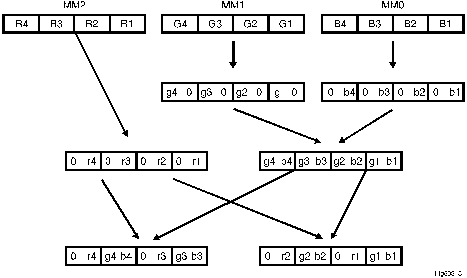
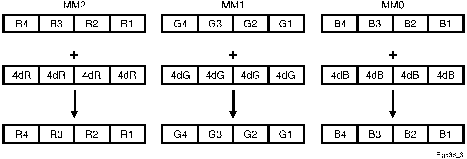
The following MMX technology instructions implement the flow described in Figure 6, that is, packing RGB color values from MM0, MM1, and MM2 into four 32-bit intensities: R1G1B1, R2G2B2, R3G3B3 and R4G4B4. MM7 in Example 4 has been assigned 0ff00H in its four words during the data setup section. It serves as a mask to clear the fractional parts of G1,G2,G3,G4 in MM4.
movq mm4, mm1 ; copy G1,G2,G3,G4 into four words of mm4 pand mm4, mm7 ; clear the fractional part of G1,G2,G3,G4 in mm4 movq mm3, mm2 ; copy R1,R2,R3,R4 into >four words of mm3 psrlw mm3, 8 ; shift the integer parts of ; R1,R2,R3,R4 to lower byte. por mm3, mm4 ; combine G1R1,G2R2,G3R3,G4R4 to four words of mm3 movq mm6, mm3 ; copy G1R1,G2R2,G3R3,G4R4 to mm6. movq mm5, mm0 ; copy B1,B2,B3,B4 into four words of mm5 psrlw mm5, 8 ; shift the integer parts of ; R1,R2,R3,R4 to lower byte. punpcklwd mm3, mm5 ; unpack B1G1R1, B2G2R2 to 2 dwords of mm3 punpckhwd mm6, mm5 ; unpack B3G3R3, B4G4R4 to 2 dwords of mm6
After pairing to optimize the MMX code, it takes 32 clocks in data setup and 10 clocks for each pass through the inner loop. Each pass processes intensities for four pixels. Table 1 shows how the number of clocks needed to process one pixel varies with the number of pixels on a scan line and shows how the number drops dramatically as the number of pixels increase.
| 4 | 50 | 12.8 |
| 8 | 60 | 7.5 |
| 12 | 70 | 5.8 |
| 16 | 80 | 5.0 |
| 20 | 90 | 4.5 |
| 40 | 140 | 3.4 |
The following code example is MMX code that implements Formula 4 for Gouraud Shading. The code has been optimized by appropriate pairing.
;****************************************************************
; Procedure Scan_ln_RGB_MMX
;
; Description:
; Procedure Scan_ln_RGB_MMX implements a RGB intensities
; interpolation on a scan line, which is a major part of the
; Gouraud shading algorithm. The function of Scan_ln_RGB_MMx
; is, knowing the RGB intensity of the starting pixel of a
; scan line and the incremental R,G,B values, calculating
; the RGB intensity for each pixel on the scan line by
; linear interpolation.
;INPUTS:
; Rgb1(DWORD): RGB intensity of the starting pixel on the scan line. Color values of R1,G1,B1 (8 bits each) are stored in first 24 bits.
; dR(SWORD): Incremental intensity of R for each successive pixel. dR is a 16-bit fixed point notation with the first 8 bits representing the fractional part and the remaining 8 bits the integer part. In the procedure, accumulation of dR includes both integer part and fractional parts, but only the integer part is used as when assigning RGB intensity to a pixel.
; dG(SWORD): refer to dR
; dB(SWORD): refer to dR
; NumP(WORD): number of pixels on the scan line.
;
; OUTPUTS:
; Rgbs(PTR DWORD): RGB intensities of all pixels on the scan line. Intensities R,G,B(each 8 bits)are stored in first 24 bits in a DWORD. In the procedure, R,G,B are calculated by linear interpolation, eg.
R(i) = R1 + i*dR,
G(i) = G1 + i*dG,
B(i) = B1 + i*dB.
i = 0, ..., NumP - 1.
; Assumption: Input 'NumP' is greater than 3. The case that NumP is fewer than 4, is handled in C code.
;*****************************************************
.486P
.MODEL FLAT, C
include iammx.inc
.Data
.Code
Public Scan_ln_RGB_MMX
Scan_ln_RGB_MMX Proc C Public USES eax ebx ecx edi,
Rgb1: DWORD, ; RGB intensities of the start pixel.
Rgbs: PTR DWORD, ; output, RGB intensities of all pixels.
dR: SWORD, ; increment of red intensity.
dG: SWORD, ; increment of green intensity.
dB1: SWORD, ; increment of blue intensity.
NumP: WORD ; number of pixels on the scan line.
;Declare local variables:
LOCAL dRed[4]: SWORD ; reserve 4 words for holding
; increment of red.
LOCAL dGreen[4]: SWORD ; reserve 4 words for holding
; increment of green.
LOCAL dBlue[4]: SWORD ; reserve 4 words for holding
; increment of blue.
LOCAL factor: QWORD ; reserve 4 words for holding
; 4 factor values
; load dR to 4 words of mm3,
; load dG to 4 words of mm4,
; load dB to 4 words of mm5
; Pack R1,G1,B1 from input Rgb1
; Load R1, R1+dR, R1+2*dR, R1+3*dR as 4 words in mm2
; Load G1, G1+dG, G1+2*dG, G1+3*dG as 4 words in mm1
; Load B1, B1+dB, B1+2*dB, B1+3*dB as 4 words in mm0
movdt mm3, [ebp + 16] ; load dR in the lowest word in mm3
pxor mm2,mm2 ; clear mm2
movdt mm4, [ebp + 20] ; load dG in the lowest word in mm4
punpcklwd mm3,mm3 ; unpack dR to lower 2 words in mm3
movdt mm5, [ebp + 24] ; load dB in the lowest word in mm5
punpcklwd mm4,mm4 ; unpack dG to lower 2 words in mm4
lea ecx, factor ; Load offset address of dRed.
Punpckldq mm3,mm3 ; unpack dR to 4 words in mm3
mov eax, 010000h
punpcklwd mm5,mm5 ; unpack dB to lower 2 words in mm5
movdt mm6, Rgb1 ; load R1,G1,B1 in lower three bytes to mm6
punpckldq mm4,mm4 ; unpack dG to 4 words in mm4
mov [ecx], eax ; store values 0,1(each 2 bytes) in
; memory location 'ecx'
punpcklbw mm6,mm6 ; unpack R1R1,G1G1,B1B1 to the first 3
; words of mm6.
mov eax, 030002h
punpckldq mm5,mm5 ; unpack dB to 4 words in mm5
movq mm7, mm6 ; load R1R1,G1G1,B1B1 to the first
; three words of mm7.
pxor mm1,mm1 ; clear mm2
mov [ecx + 4], eax ; store values 2,3(each 2 bytes) in
; memory location 'ecx + 4'
punpcklwd mm7,mm7 ; unpack R1R1,R1R1,G1G1,G1G1 to 4
; words of mm7.
Movq mm0, mm3 ; unpack R1 to the higher bytes of the
; 4 words of mm7
punpcklbw mm2,mm7 ; unpack R1 to the higher bytes of
; the 4 words of mm2
pmullw mm0, [ecx] ; multiplied by [3,2,1,0], mm0
; becomes [3dR,2dR,dR,0]
punpckhbw mm1,mm7 ; unpack G1 to the higher bytes of
; the 4 words of mm1
lea edi, dRed ; Load offset address of dRed.
psllw mm3, 2 ; mulitiply each dR in 4 words of mm3 by 4
paddsw mm2, mm0 ; 4 words in mm2 becomes R1, R1+dR,
; R1+2dR, R1+3dR
punpckhbw mm6,mm6 ; unpack B1 to the first 4 bytes of mm6
movq [edi], mm3 ; store 4 dR to consecutive memory
; location: dRed[4]
movq mm0, mm4 ; load dG to 4 words of mm0
pmullw mm0, [ecx] ; multiplied by [3,2,1,0], mm0 becomes
; [3dG,2dG,dG,0]
psllw mm4, 2 ; mulitiply each dG in 4 words of mm4 by 4
mov ebx, Rgbs ; Load address of *Rgbs for storing intensities
movq mm7, mm5 ; load dB to 4 words of mm7
mov eax, 0ff00ff00h
paddsw mm1, mm0 ; 4 words in mm2 becomes G1, G1+dG,
; G1+2dG, G1+3dG
pmullw mm7, [ecx] ; multiplied by [3,2,1,0], mm7
; becomes [3dB,2dB,dB,0]
pxor mm0,mm0 ; clear mm0
movq [edi - 8], mm4 ; store 4 dG to consecutive memory
; location: dGreen[4]
psllw mm5, 2 ; mulitiply each dB in 4 words of mm5 by 4
xor ecx, ecx ; clear ecx as a counter of j
punpcklbw mm0,mm6 ; unpack B1 to the higher bytes of the
; 4 words of mm0
movq [edi - 16], mm5 ; store 4 dB to consecutive memory
; location: dBlue[4]
paddsw mm0, mm7 ; 4 words in mm0 becomes B1, B1+dB,
; B1+2dB, B1+3dB
movdt mm7, eax ; load 0ff00ff00h to the first dword of mm7
movq mm3,mm2 ; load R1,R2,R3,R4 to 4 words of mm3
xor eax, eax ; clear eax
movq mm4,mm1 ; load G1,G2,G3,G4 to 4 words of mm4
mov ax, numP ; load numP to eax
punpckldq mm7,mm7 ; mm7(0ff00ff00ff00ff00h) will serve as
; a mask in J loop
;For each pass through of loopJ, RGB intensities of four
;pixels will be calculated and stored to the destination
;memory location of Rgbs[]. If numP is not a multitple of
;4, there will be up to 3 extra intensities assignment in
;the last pass of the loop. Caller should allocate enough
;memory for holding the extra intensities.
loopJ:
pand mm4, mm7 ; clear the fractional part of
; G1,G2,G3,G4 in mm4
psrlw mm3, 8 ; shift the integer parts of R1,R2,R3,R4
; to lower byte.
movq mm5,mm0 ; copy B1,B2,B3,B4 into 4 words of mm5
por mm3,mm4 ; combine G,R and load G1R1, G2R2,
; G3R3, G4R4 to 4 ;words of mm3
psrlw mm5, 8 ; shift the integer parts of
; B1,B2,B3,B4 to lower bytes
movq mm6,mm3 ; copy G1R1,G2R2,G3R3,G4R4 to mm6.
paddw mm2, [edi] ; add (4dR,4dR,4dR,4dR) to
; (R1,R2,R3,R4) in mm2.
punpcklwd mm3,mm5 ; unpack B1G1R1,B2G2R2 to 2 dwords of mm3
paddw mm1, [edi - 8] ; add (4dG,4dG,4dG,4dG) to
; (G1,G2,G3,G4) in mm1
punpckhwd mm6,mm5 ; unpack B3G3R3, B4G4R4 to 2 dwords of mm6
paddw mm0, [edi - 16] ; add (4dB,4dB,4dB,4dB) to
; (B1,B2,B3,B4) in mm0
movq mm4,mm1 ; copy G1,G2,G3,G4 into 4 words of mm4
movq [ebx +4*ecx],mm3 ; store two B1G1R1, B2G2R2 to
; memory location
movq mm3,mm2 ; copy R1,R2,R3,R4 into 4 words of mm3
movq 8 [ebx +4*ecx], mm6 ; store B3G3R3, B4G4R4 to memory
; location
add ecx, 4 ; increase the J-counter by 4.
cmp ecx, eax ; compare counter ecx with num_Pjl
; if ecx < numP, continue for next four pixels
emms ; clear floating point stack
ret
Scan_ln_RGB_MMX EndP
END